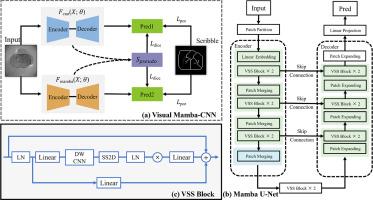光声断层成像弱监督学习中基于涂鸦的视觉Mamba-CNN分割
IF 7.5
1区 计算机科学
Q1 COMPUTER SCIENCE, ARTIFICIAL INTELLIGENCE
引用次数: 0
摘要
光声成像(PA)是一种强大的非侵入性医学成像技术,它将光学成像的高对比度与超声的深层组织穿透相结合,提供对组织和器官的结构和功能的洞察。光声断层扫描(PAT)图像的器官水平分析可以量化特定的形态和功能参数,使准确的器官分割成为基于PA图像分析的关键步骤。然而,大规模带注释的数据集的有限可用性仍然是一个主要挑战。为了解决这个问题,我们通过从MRI扫描中生成合成PA图像来采用跨模态数据增强。为了进一步减少手工注释的工作量,我们提出了一个利用潦草注释的弱监督学习(WSL)框架。由于许多深度学习模型难以从稀疏标签中捕获全局上下文,我们引入了一种将传统卷积神经网络(cnn)与Visual Mamba相结合的新架构,集成了局部和全局特征提取功能。这种混合设计提高了弱监督设置下的分割性能。我们在模拟的PA腹部数据集和真实的体内小鼠腹部PAT数据上验证了我们的方法,证明了分割精度和鲁棒性的显着提高。本文章由计算机程序翻译,如有差异,请以英文原文为准。

Visual Mamba-CNN for scribble-based segmentation in weakly supervised learning for photoacoustic tomography
Photoacoustic (PA) imaging is a powerful non-invasive medical imaging technique that combines the high contrast of optical imaging with the deep tissue penetration of ultrasound, offering both structural and functional insights into tissues and organs. Organ-level analysis of photoacoustic tomography (PAT) images enables quantification of specific morphological and functional parameters, making accurate organ segmentation a critical step in PA image-based analysis. However, the limited availability of large-scale annotated datasets remains a major challenge. To address this, we employ cross-modality data augmentation by generating synthetic PA images from MRI scans. To further reduce manual annotation efforts, we propose a weakly supervised learning (WSL) framework that leverages scribble annotations. Since many deep learning models struggle to capture global context from sparse labels, we introduce a novel architecture that combines traditional convolutional neural networks (CNNs) with Visual Mamba, integrating both local and global feature extraction capabilities. This hybrid design improves segmentation performance in weakly supervised settings. We validate our method on a simulated PA abdominal dataset and real in vivo mouse abdominal PAT data, demonstrating notable improvements in segmentation accuracy and robustness.
求助全文
通过发布文献求助,成功后即可免费获取论文全文。
去求助
来源期刊

Expert Systems with Applications
工程技术-工程:电子与电气
CiteScore
13.80
自引率
10.60%
发文量
2045
审稿时长
8.7 months
期刊介绍:
Expert Systems With Applications is an international journal dedicated to the exchange of information on expert and intelligent systems used globally in industry, government, and universities. The journal emphasizes original papers covering the design, development, testing, implementation, and management of these systems, offering practical guidelines. It spans various sectors such as finance, engineering, marketing, law, project management, information management, medicine, and more. The journal also welcomes papers on multi-agent systems, knowledge management, neural networks, knowledge discovery, data mining, and other related areas, excluding applications to military/defense systems.
 求助内容:
求助内容: 应助结果提醒方式:
应助结果提醒方式:


